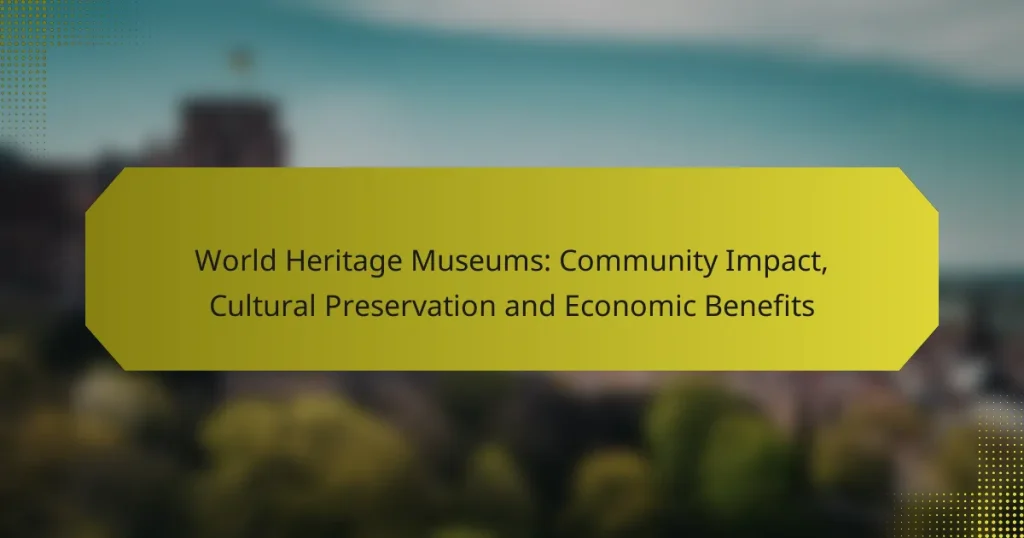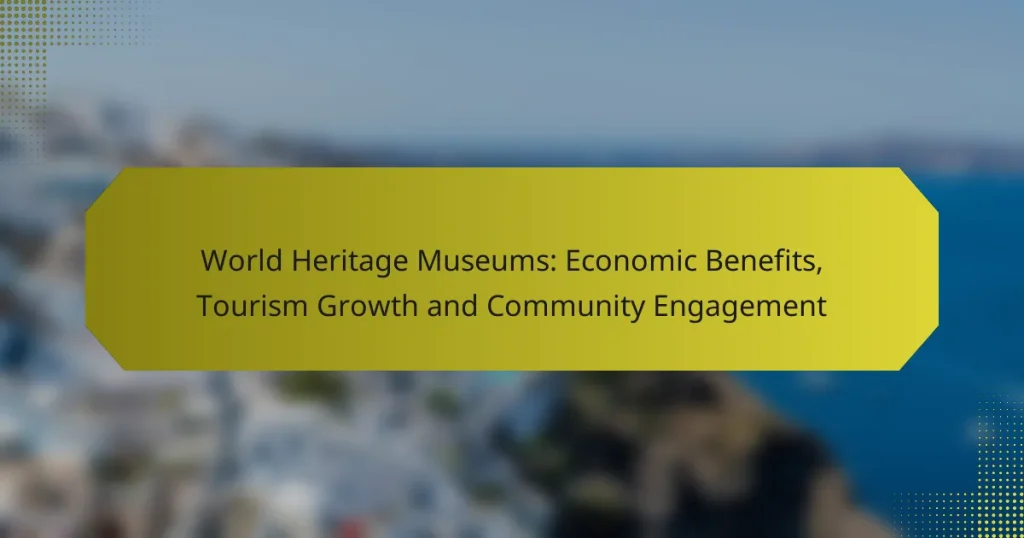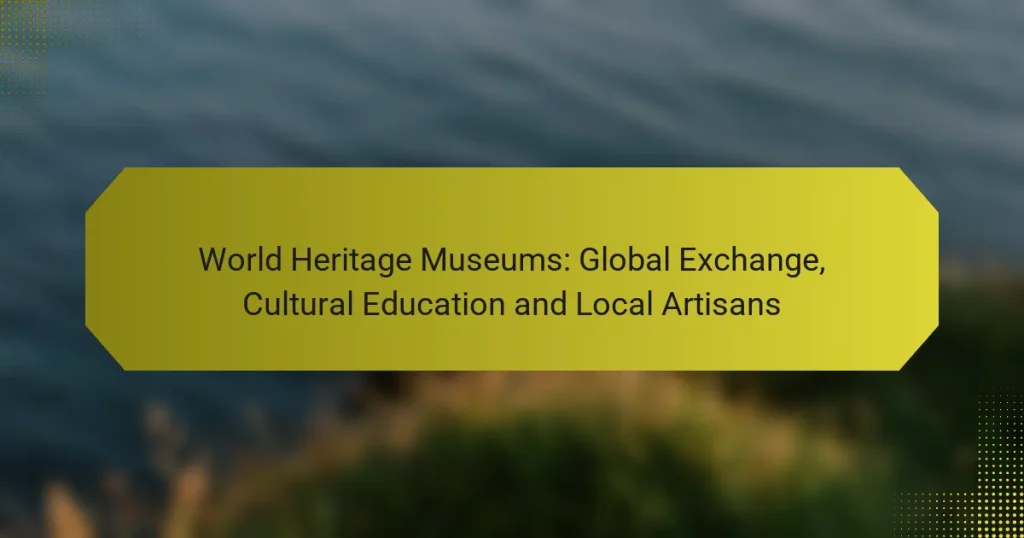World Heritage Museums are essential for preserving and showcasing the unique cultural identities of communities around the globe. By acting as custodians of local history and traditions, these museums foster a sense of belonging while also contributing to economic growth and educational opportunities through their diverse collections and programs.
World Heritage Museums: Cultural Education, Youth Programs and Community Involvement
World Heritage Museums: UNESCO Designation, Cultural Significance and Global Recognition
World Heritage Museums: Community Impact, Cultural Preservation and Economic Benefits
World Heritage Museums: Economic Benefits, Tourism Growth and Community Engagement
World Heritage Museums: Global Exchange, Cultural Education and Local Artisans
World Heritage Museums: Artisan Influence, Exhibit Design and Cultural Representation
How do World Heritage Museums impact cultural identity?
World Heritage Museums play a crucial role in shaping and preserving cultural identity by showcasing the unique heritage of communities. They serve as custodians of local history, traditions, and artistic expressions, fostering a sense of belonging and continuity among people.
Preservation of local traditions
World Heritage Museums actively engage in the preservation of local traditions by documenting and displaying artifacts, practices, and narratives that define a community’s cultural heritage. This includes organizing workshops, exhibitions, and educational programs that highlight traditional crafts, music, and rituals.
For example, a museum in Bulgaria might focus on preserving the art of pottery-making, providing resources and training to artisans while showcasing their work to visitors. Such initiatives not only safeguard these traditions but also encourage their transmission to future generations.
Promotion of cultural diversity
World Heritage Museums promote cultural diversity by representing various cultural narratives and encouraging intercultural dialogue. They often feature exhibitions that celebrate the richness of different cultures, fostering an appreciation for global heritage.
By collaborating with international organizations, these museums can host traveling exhibitions that introduce visitors to diverse cultural expressions, such as indigenous art from South America or traditional dance from Africa. This exposure helps to cultivate respect and understanding among different cultural groups.
Enhancement of community pride
World Heritage Museums enhance community pride by serving as symbols of local identity and achievement. They provide a space for communities to celebrate their unique heritage and share it with others, reinforcing a collective sense of belonging.
Local events, such as heritage festivals hosted by these museums, can draw significant attendance, showcasing traditional foods, music, and crafts. This not only boosts local tourism but also instills a sense of pride among residents as they share their culture with visitors.
What are the economic benefits of World Heritage Museums?
World Heritage Museums provide significant economic benefits by attracting tourists, creating jobs, and supporting local businesses. These museums serve as cultural hubs that stimulate local economies and enhance community development.
Tourism revenue generation
World Heritage Museums attract millions of visitors each year, contributing substantially to local tourism revenue. Entrance fees, guided tours, and special exhibitions generate income that can be reinvested into the community.
For example, a popular museum might see ticket sales in the range of hundreds of thousands to millions of dollars annually, depending on its location and visitor appeal. This influx of tourists often leads to increased spending in nearby hotels, restaurants, and shops.
Job creation in local communities
The presence of World Heritage Museums leads to job creation in various sectors, including hospitality, retail, and museum operations. These institutions require staff for roles such as curators, educators, and maintenance workers, providing employment opportunities for local residents.
Additionally, the tourism sector surrounding these museums often expands, creating further jobs in service industries. Communities may see job growth in the low hundreds to thousands, depending on the museum’s size and visitor numbers.
Support for local artisans and businesses
World Heritage Museums often collaborate with local artisans and businesses, promoting cultural heritage and craftsmanship. Gift shops within museums frequently feature handmade products, providing artisans with a platform to reach a wider audience.
This support can lead to increased sales for local businesses, as tourists seek souvenirs and authentic experiences. By fostering these connections, museums contribute to the sustainability of local economies and cultural preservation.
How do World Heritage Museums contribute to education?
World Heritage Museums play a vital role in education by providing access to diverse cultural artifacts and knowledge. They facilitate learning experiences that engage visitors and promote understanding of global heritage.
Educational programs for schools
Many World Heritage Museums offer tailored educational programs designed specifically for school groups. These programs often include guided tours, interactive exhibits, and hands-on activities that align with curriculum standards.
For example, a museum might provide workshops that focus on local history or global cultures, allowing students to explore topics in depth. Schools can often book these programs at affordable rates, making them accessible to a wide range of educational institutions.
Workshops and cultural exchanges
Workshops and cultural exchanges at World Heritage Museums foster collaboration and understanding among different communities. These events often involve artists, historians, and educators who share their expertise and cultural practices with participants.
Such exchanges can take the form of art workshops, cooking classes, or storytelling sessions, providing immersive experiences that deepen appreciation for cultural diversity. Museums may also partner with local organizations to enhance these programs, ensuring they reflect the community’s unique heritage and values.
What criteria determine World Heritage status for museums?
World Heritage status for museums is determined by criteria set by UNESCO, which include cultural significance, integrity, and authenticity. These criteria ensure that the museum not only represents outstanding universal value but also maintains its historical and cultural integrity.
Outstanding universal value
Outstanding universal value refers to the significance of a museum that transcends national boundaries and is recognized as important for all humanity. This can include unique collections, exceptional architecture, or significant historical narratives. For example, a museum housing artifacts from ancient civilizations may be considered for its role in understanding human history globally.
To meet this criterion, museums should demonstrate how their collections contribute to a broader understanding of cultural heritage. This often involves showcasing unique items or narratives that resonate with diverse audiences worldwide.
Integrity and authenticity
Integrity and authenticity assess whether a museum preserves its original materials, structure, and context. A museum must maintain its physical and cultural integrity to be considered for World Heritage status. This includes ensuring that exhibits are displayed in a manner that reflects their true historical context.
To uphold integrity, museums should avoid alterations that compromise their original state. Authenticity can be demonstrated through proper documentation and conservation practices, ensuring that artifacts and exhibits remain true to their origins. Regular assessments and adherence to conservation standards are crucial for maintaining this status.
Which notable World Heritage Museums are recognized globally?
Several museums are recognized as World Heritage sites due to their cultural significance and historical value. Notable examples include the Louvre Museum in France, the British Museum in the United Kingdom, and the Smithsonian Institution in the USA.
Louvre Museum, France
The Louvre Museum, located in Paris, is the world’s largest art museum and a historic monument. It houses over 35,000 works, including the famous Mona Lisa and the Venus de Milo, attracting millions of visitors annually.
As a World Heritage site, the Louvre not only showcases art but also serves as a cultural hub, hosting exhibitions and educational programs. Its architecture, a blend of the historic palace and modern glass pyramid, enhances its significance.
British Museum, United Kingdom
The British Museum in London is renowned for its vast collection of world art and artifacts, including the Rosetta Stone and the Elgin Marbles. Established in the 18th century, it offers free admission, making it accessible to a wide audience.
This museum plays a crucial role in preserving global heritage and promoting cultural understanding. Its extensive research programs and exhibitions allow visitors to engage with history from diverse perspectives.
Smithsonian Institution, USA
The Smithsonian Institution, located in Washington, D.C., comprises multiple museums and research centers, including the National Museum of American History and the National Air and Space Museum. It is the largest museum complex in the world, with a mission to educate and inspire.
With free entry to its museums, the Smithsonian attracts millions of visitors each year. Its collections span various fields, from art to science, making it a vital resource for cultural preservation and public education.
How do World Heritage Museums foster international cooperation?
World Heritage Museums promote international cooperation by serving as platforms for cultural exchange and collaboration among nations. They facilitate joint projects, exhibitions, and research initiatives that enhance understanding and appreciation of diverse cultures.
Collaborative exhibitions
Collaborative exhibitions are a key way World Heritage Museums foster international cooperation. These exhibitions often feature artifacts and artworks from multiple countries, showcasing shared histories and cultural narratives. By pooling resources and expertise, museums can create more impactful displays that resonate with a global audience.
For example, a collaborative exhibition might bring together ancient artifacts from Egypt and Greece to explore their interconnected histories. Such partnerships not only enrich the visitor experience but also strengthen ties between the participating countries.
To successfully implement collaborative exhibitions, museums should establish clear communication channels and shared goals. Regular meetings and updates can help ensure that all parties are aligned and that the exhibition meets the expectations of each contributing institution.






